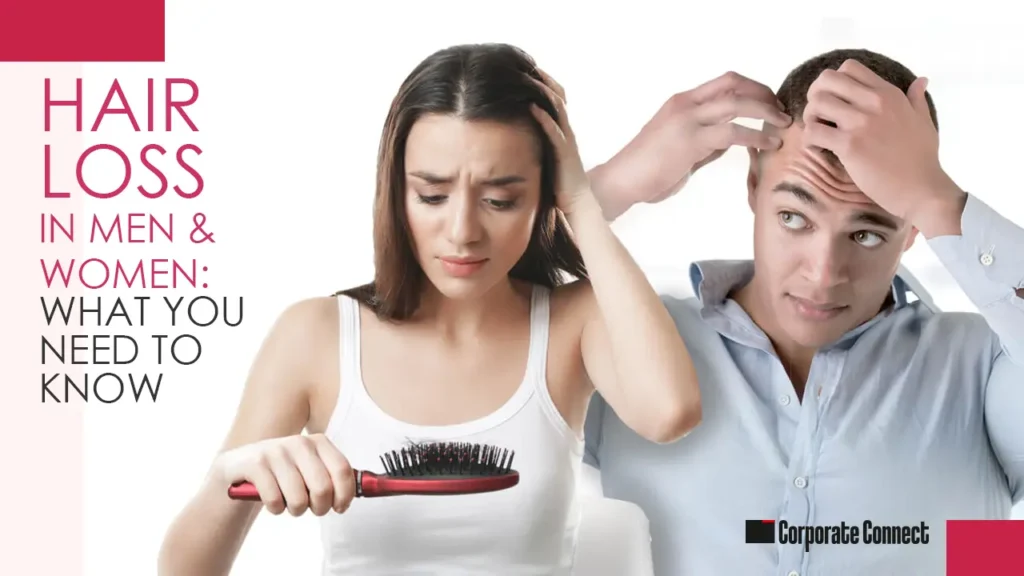Hair Loss in Men & Women: What You Need to Know
Written By Jaya Pathak
HAIR: How can it boost confidence? Ever wondered?? Yes, it really can!! It might look very nominal but here represents clarity and confidence in workplace. In India, especially among youths, hair loss has become a major problem.
For some people, it starts with tenor temples or a widening part. For others it follows illness or a demanding quarter or even a hormonal change. Treating hair loss has become a major health concern. It is not considered as a cosmetic flaw rather it is linked with health and well-being issue.
What hair loss actually means
Clinicians group most conditions that reduce scalp density under the term alopecia. The dominant form is pattern hair loss: men usually notice a receding hairline and crown thinning; women more often see a gradual, diffuse reduction in volume across the top of the scalp. Other routes exist. Autoimmune disorders can create patchy loss. After a major stressor or illness, shedding may surge a few months later (telogen effluvium). Long-term traction from tight styles, frequent bleaching, or high heat can damage follicles. Daily shedding of some hairs is normal; visible density change is what calls for action.
Why professionals should care
– Presence and performance: When someone is uneasy about appearance, it can show up as camera avoidance, skipped panels, or less willingness to lead from the front.
– Focus and energy: Persistent worry siphons attention. Addressing the issue clinically—and normalizing it at work—removes a quiet drag on performance.
– Talent retention: Access to credible specialists, coverage for evidence-backed care, and flexible appearance policies signal a culture that looks after people.
Factors leading to hair loss:
- Genetics: It is one of the strong driving factors responsible for hair loss period if someone in your family had this issue, it is likely to be passed to you as well.
- Hormones: Hormones affect hair loss period if you are facing thyroid shifts or undergoing postpartum changes, all such factors can affect the hair growth cycle. Menopause as well as androgen sensitivity can also affect the growth cycle of your hairs.
- Stress: If you are feeling a high pressure then it can push your follicles into a resting phase which can produce delayed shedding. Yellows can also be caused due to surgery or some severe infection.
- Styling and usage of chemicals: If you are the one who’s involving in braiding their hairs quite tight or straightening frequently or using harsh bleaching, all such factors can contribute to breakage or even loss off your hairs.
Start with diagnosis, not products
What should one do when a problem such as hair loss knocks the door? The most cost-effective way is the evaluation done by a specialist. You can consult a dermatologist or a hair and scalp cleaning. They will take a detailed history and examine your scalp. Instead of trying variety of products which even can damage your hairs, you must consult a specialist.
Treatment options in plain language
- You can look for some topical therapies. Minoxidil is widely known first line option for pattern loss in both men and women. But you must use it for months steadily.
- You can take up some oral medicines which can be used for both men and women. Finasteride is a medicine which is used by men with androgen driven laws. Women can be offered some alternatives under specialist oversight.
- Platelet rich plasma injections and low-level laser therapy can also be used as adjunctions to improve the density and quality of hair.
- Men and women can undergo surgical restoration such as follicular unit extraction and some other techniques which can help to move resilient follicles to the thinning areas once the loss is stable.
- You can also use some supportive measures such as taking iron and vitamin D pills. You can prioritize protein intake and reduce heat and chemical exposure. You must adopt practical stress routines which suits your schedules.
Timelines and expectations
Hair growth follows a slow cycle. Credible treatments usually need three to six months for early traction and nine to twelve months for visible change. Stopping therapy commonly leads to gradual regression. A simple discipline helps: baseline photos in consistent lighting, a 90-day check for adherence and side effects, and 6–12-month comparisons for results.
Women’s hair loss needs early attention
Because thinning is often spread out, women may present later. Associated cues—irregular cycles, acne, or weight change—can point to endocrine contributors that benefit from coordinated care. Early engagement preserves options and can avoid avoidable progression.
What organizations can do
– Normalize the topic: Treat hair loss as a health matter. Offer confidential pathways to vetted clinicians through benefits or partnerships.
– Offer practical flexibility: During active shedding or early treatment, be considerate about on-camera expectations, stage lighting, or high-visibility events if an employee requests adjustments.
– Clarify policy: Appearance standards should allow medical accommodations; clear language reduces uncertainty and stigma.
A buying checklist
You can start with treatments by consulting are dermatologist before spending on quick fix claims. Track your progress through monthly photos with the same light and same angle. It will help you to segregate the real change from day-to-day noise. Afterwards, you can look for some realistic timelines and clear the maintenance plans and transparent risk. However, you must keep in your mind that one size might not fit all.
Four steps to take this week
- Book a specialist if thinning has been noticeable for three months or more.
- Complete baseline labs if recommended and address correctable deficiencies.
- You can start by a simple routine. You can begin by short and repeatable stress releases, for that purpose you can indulge in breath working and walking. You can take care of your hair gently.
- You can set a calendar reminder for say 6 month photo reviews.
Conclusion
Hair loss is common and personal. It touches identity and confidence, but it is also a clinical question with clear diagnostic steps and credible treatments. Those who act early and choose evidence over hype tend to regain control—of routine, presence, and focus. Employers that respond with empathy and practical support see steadier teams and better work. The goal is not perfect hair; it is a plan that restores confidence so attention stays where it belongs: on the work that matters.










